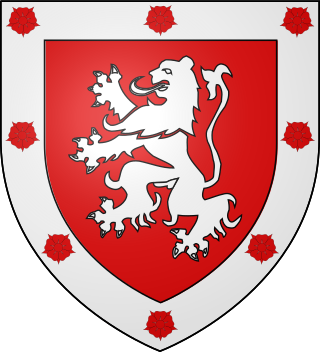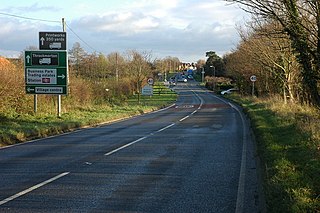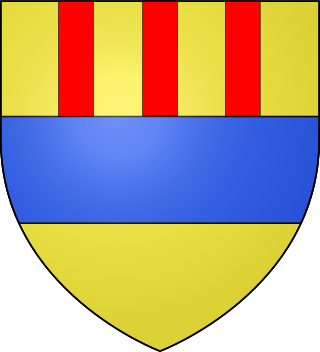
Earl of Lincoln is a title that has been created eight times in the Peerage of England, most recently in 1572. The title was borne by the Dukes of Newcastle-under-Lyne from 1768 to 1988, until the dukedom became extinct.

Earl of Rothes is a title in the Peerage of Scotland. It was created in 1458 for George Leslie, 1st Lord Leslie. He had already been created Lord Leslie in 1445, also in the Peerage of Scotland. His grandson, the third Earl, having only succeeded his elder brother in March 1513, was killed at the Battle of Flodden on 9 September of the same year. His son, the fourth Earl, served as an Extraordinary Lord of Session. Lord Rothes was also tried for the murder of Cardinal Beaton but was acquitted.

Earl of Elgin is a title in the Peerage of Scotland, created in 1633 for Thomas Bruce, 3rd Lord Kinloss. He was later created Baron Bruce, of Whorlton in the County of York, in the Peerage of England on 30 July 1641. The Earl of Elgin is the hereditary Clan Chief of Clan Bruce.

Duke of Leeds was a title in the Peerage of England. It was created in 1694 for the prominent statesman Thomas Osborne, 1st Marquess of Carmarthen, who had been one of the Immortal Seven in the Revolution of 1688. He had already succeeded as 2nd Baronet, of Kiveton (1647) and been created Viscount Osborne, of Dunblane (1673), Baron Osborne, of Kiveton in the County of York and Viscount Latimer, of Danby in the County of York, Earl of Danby, in the County of York (1674), and Marquess of Carmarthen (1689). All these titles were in the Peerage of England, except for the viscountcy of Osborne, which was in the Peerage of Scotland. He resigned the latter title in favour of his son in 1673. The Earldom of Danby was a revival of the title held by his great-uncle, Henry Danvers, 1st Earl of Danby.
Scrope is the name of an old English family of Norman origin that first came into prominence in the 14th century. The family has held the noble titles of Baron Scrope of Masham, Baron Scrope of Bolton, and for a brief time, the Earl of Wiltshire.
Patrick III, 7th Earl of Dunbar was lord of the feudal barony of Dunbar and its castle, which dominated East Lothian, and the most important military personage in the Scottish Borders.

Robert I de Brus, 1st Lord of Annandale was an early-12th-century Anglo-Norman lord and the first of the Bruce dynasty to hold lands in Scotland. A monastic patron, he is remembered as the founder of Gisborough Priory in Yorkshire, England, in present-day Redcar and Cleveland, in 1119.
Robert II de Brus, le Meschin was a 12th-century Norman noble and 2nd Lord of Annandale. He was the son, perhaps the second son, of Robert de Brus, 1st Lord of Annandale.
William de Brus, 3rd Lord of Annandale, was the second but eldest surviving son of Robert de Brus, 2nd Lord of Annandale.

George de Dunbar, 10th Earl of Dunbar and March (1338–1422), 12th Lord of Annandale and Lord of the Isle of Man, was "one of the most powerful nobles in Scotland of his time, and the rival of the Douglases."

Earl of Oxford and Earl Mortimer was a title in the Peerage of Great Britain. It was created in 1711 for the statesman Robert Harley, with remainder, failing heirs male of his body, to those of his grandfather, Sir Robert Harley. He was made Baron Harley, of Wigmore in the County of Hereford, at the same time, also in the Peerage of Great Britain and with similar remainder as for the earldom. Harley was the eldest son of Sir Edward Harley and the grandson of the aforementioned Sir Robert Harley.

Sir Marmaduke Thweng, later 1st Baron Thweng, was an English knight from Yorkshire who fought in the Wars of Scottish Independence.
Matilda of Chester, Countess of Huntingdon was an Anglo-Norman noblewoman, sometimes known as Maud and sometimes known with the surname de Kevelioc. She was a daughter of Hugh de Kevelioc, 5th Earl of Chester, and the wife of David of Scotland, Earl of Huntingdon.
Richard Grey, 3rd Earl of Tankerville, 8th Lord of Powys fought on the side of the House of York in the War of the Roses.

Thomas Spring of Lavenham in Suffolk, was an English cloth merchant. He consolidated his father's business to become one of the most successful in the booming wool trade of the period and was one of the richest men in England. He has been described as the most important figure of the early Tudor cloth industry.
The Lord of Skelton was a title in the Peerage of England.

Richard Neville, 2nd Baron Latimer KB of Snape, North Yorkshire, was an English soldier and peer. He fought at the battles of Stoke and Flodden.

William Neville of Penwyn and Wyke Sapie, Worcestershire, was the son of Richard Neville, 2nd Baron Latimer, and the author of The Castell of Pleasure. In 1532 he was accused of treason and dabbling in magic.

Walter de Fauconberg, 1st Baron Fauconberg, Lord of Rise, Withernwick and Skelton, was an English noble. He fought in the wars in Flanders and was a signatory of the Baron's Letter to Pope Boniface VIII in 1301.
John Lindsay, 8th Lord Lindsay PC, was a Scottish landowner.










